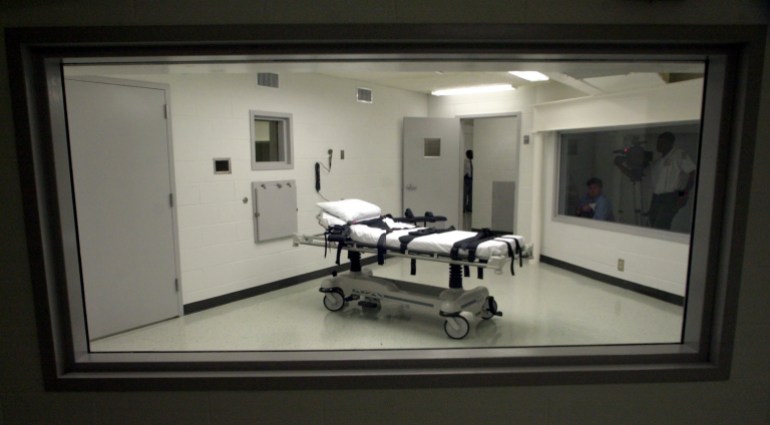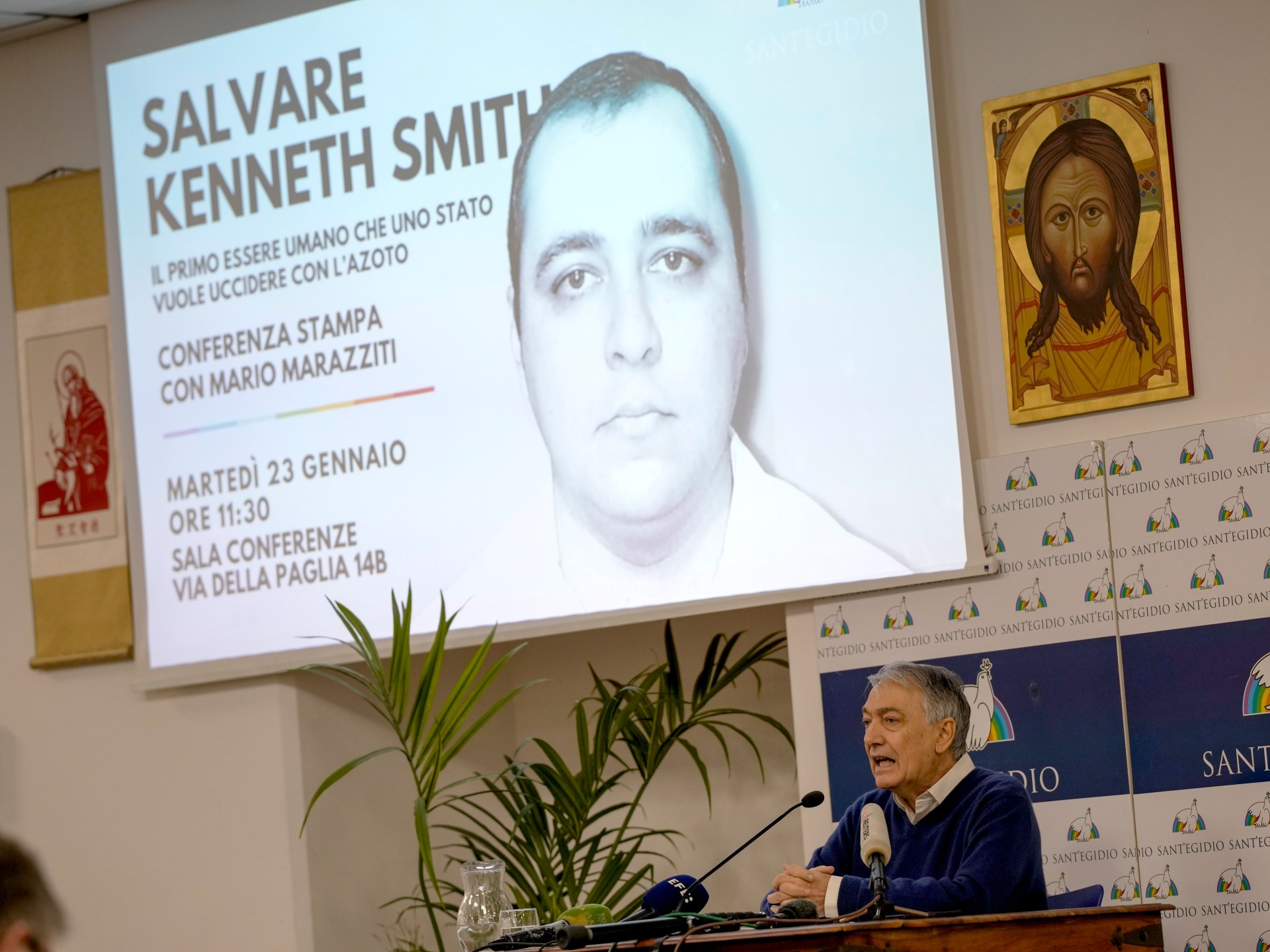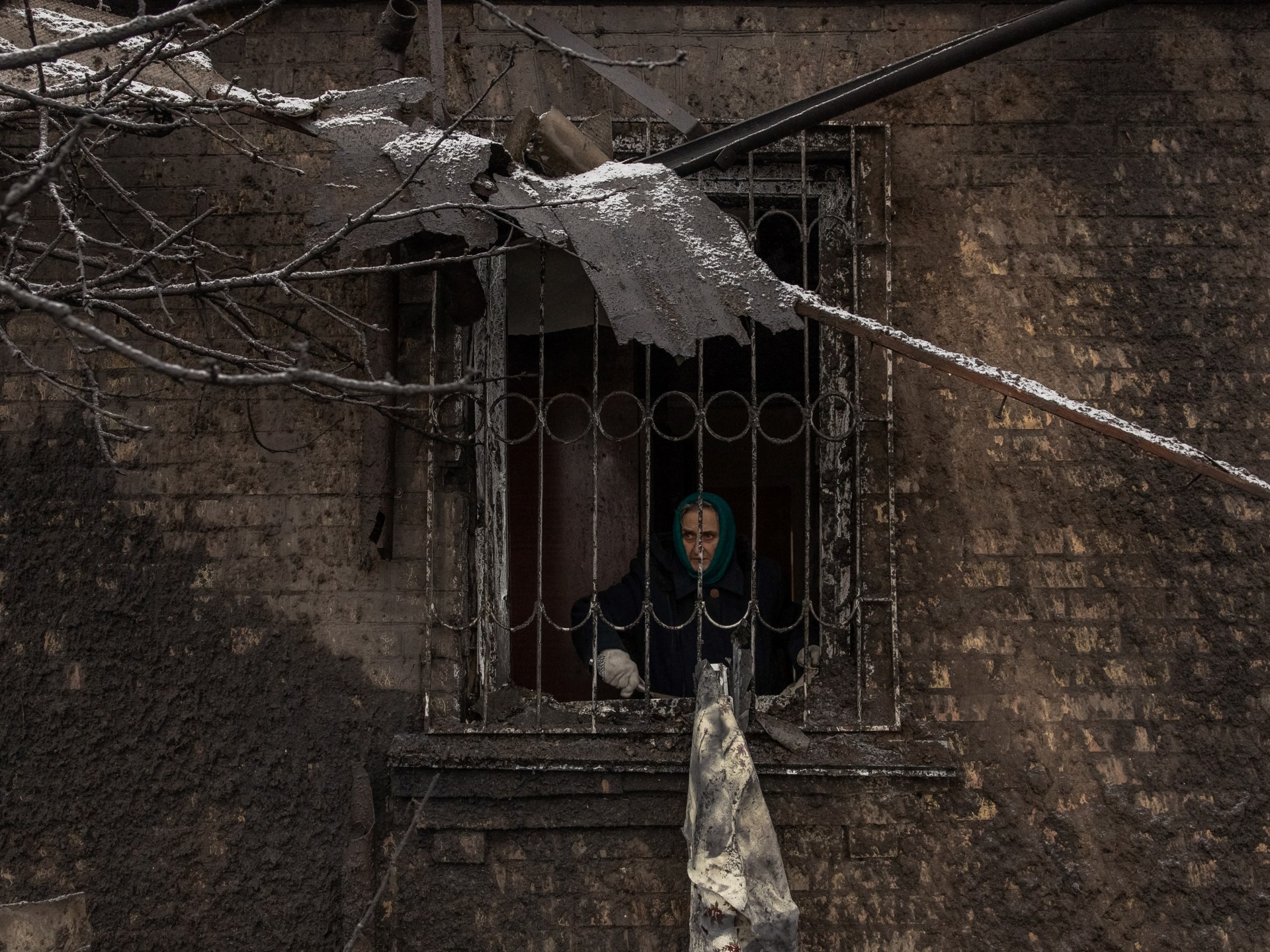What’s nitrogen hypoxia? Alabama prepares for Kenneth Smith’s US execution | Prison News
Alabama, a US state with 165 people on death row, is on Thursday night expected to attempt the first-ever execution by an untested method known as nitrogen hypoxia.
Only two years after a botched execution attempt on him, Kenneth Eugene Smith will once again be made to face death, this time through an experimental technique that pumps pure nitrogen gas into a person’s lungs instead of the regular air that has the oxygen humans need to breathe.
Smith’s execution in the United States is moving forward despite criticism from rights groups, some doctors and the jury for the case itself voting against the death penalty.
What’s the case about, how does the nitrogen hypoxia method work, and what are lawyers and rights groups saying about it?
Who is Kenneth Eugene Smith and what did he do?
Smith, 58, is one of two men convicted for the murder of Elizabeth Sennett, 45, on March 18, 1988.
Smith and John Forrest Parker were each paid $1,000 to kill Sennett on behalf of her pastor husband, Charles Sennett Sr, who was in debt and wanted to collect insurance money from her death.
Parker was executed by lethal injection in 2010 while Sennett Sr committed suicide after he became a prime suspect in the case, according to court records.
Smith claims that while he was present at the site of the killing, he did not take part in the attack. He has been on death row since 1996.
Why is this the second time Smith is facing a death sentence?
Smith suffered a failed execution attempt via lethal injection in 2022.
The attempt was called off at the last minute because authorities struggled to insert an intravenous line that would have transmitted deadly drugs through his veins.
Smith’s lawyers have argued that a second execution attempt would exacerbate the psychological trauma he has been experiencing since the first attempt.
When is Kenneth Eugene Smith’s execution?
His execution is set to take place within a 30-hour time frame beginning at 12am local time (06:00 GMT) on Thursday and expiring at 6am (12:00 GMT) the following day.
Human rights lawyer Clive Stafford Smith, who has argued against the death penalty in several countries including the US, points out that executions are commonly held only in the middle of the night.
“And that’s because we’re basically ashamed of what we do,” he told Al Jazeera.
Stafford Smith has had to watch the executions of six of his clients in the US. “And each time I’ve come out of the execution chamber, I look up at the stars and say to myself, honestly, can we say that this makes the world the most civilised place?”
What is nitrogen hypoxia and how does it work?
Nitrogen hypoxia is a method of execution where a respirator mask is placed over the inmate’s face, and their breathing air is replaced with pure nitrogen gas.
This deprives the individual of oxygen, leading to unconsciousness in a few seconds, and ultimately causing death in several minutes.
Smith’s lawyers have raised concerns over the untested nature of the method that could go awry. For instance, the mask may not be airtight enough and cause Smith to choke on his own vomit.
Alabama Solicitor General Edmund LaCour said that such claims are speculative, and suggested that he could opt “to have his last meal earlier in the day, or the day before the planned execution”, to minimise such a risk.
LaCour also told federal judges that nitrogen hypoxia is “the most painless and humane method of execution known to man.”
According to Stafford Smith, the lawyer, nitrogen hypoxia as an execution method originated from a television programme 15 years ago, featuring former British Member of Parliament Michael Portillo seeking alternatives to US execution methods.
Portillo discovered that the Royal Netherlands Air Force was experimenting with low nitrogen in the air for its pilots. He claimed it was a more humane way to execute people than lethal injection — he described a sort of euphoria before he drifted into unconsciousness when he tried breathing in nitrogen himself.

How does lethal injection work?
Protocol suggests that inmates must go through a “three-drug procedure” where they are first given an anaesthetic to make them unconscious. Most states use “barbiturate” for this step, which has become difficult to obtain in the US.
Next, a substance is given to paralyse muscles, and then a final drug is given in a dose that stops the heart. Several US states, including Alabama since 2013, have switched over to a “one-drug procedure” where only barbiturate or its alternative is given in a lethal dose.
In either case, the entire process up until death can last up to five minutes. However, botched lethal injections have sometimes taken more than two hours before death. The procedure also requires the inmate to be strapped to a gurney.

Does Smith get to choose how he is executed?
After Smith suffered the botched execution attempt by lethal injection in 2022, he appealed against a repeat.
Enter the US judicial system. Two US Supreme Court judgements have determined that if convicts on death row claim that a particular method of execution is unacceptable to them because it is too cruel, they are required to choose another method that is available in that state.
Alabama, along with Oklahoma and Mississippi, has also approved the use of nitrogen hypoxia as an alternative to the lethal injection. That meant that when Smith said he did not want a second stab with a lethal injection, he was in effect also forced to accept nitrogen hypoxia as the method of his execution. California, Texas, Florida and Alabama are the US states with the most inmates on death row. Texas has carried out, by far, the most executions over the last 50 years.
What else do we know about execution methods in the US?
Lethal injection is the most common form of execution in the US, and was also introduced as an experimental and “gentler” method in 1982.
Although there is backlash against the experimental nature of nitrogen hypoxia, Stafford Smith points out that it only continues with a macabre US tradition. “We’ve experimented with killing our citizens for a long time, if you go back to the early days of the electric chair,” he said.
The drugs used for executions have become increasingly difficult to find following a European Union law that bans pharmaceutical companies from selling substances to prisons for them to be used in executions.
That in turn has left US correctional facilities searching for other options to execute people.
Meanwhile, Alabama alone has carried out three botched attempts at lethal injection since 2018.
The last time the US put someone to death using gas was in 1999, when a convicted murderer was executed using hydrogen cyanide gas.
Is Kenneth Smith’s execution against the US Constitution?
Smith’s attorneys argue that a second execution attempt, and specifically the use of nitrogen gas, may violate the Eighth Amendment of the US Constitution, which prohibits “cruel and unusual” punishment.
They explain that its untested nature and the risks associated with it could constitute as cruel and unusual.
In 1996 the jury on Smith’s case voted 11-1 against execution and suggested a life sentence instead. Although the judge overruled that decision, Smith would not be on death row if tried today after Alabama abolished judicial override on a life sentence in 2017.
“Of course, what they want to do is not apply that rule retroactively to this case”, said Stafford Smith. “So this is a classic example of the way that the American system operates”.
What do doctors and human rights organisations say?
Rights organisations, including the Death Penalty Information Center and United Nations, have raised concerns about the state’s plan to use nitrogen gas.
Four UN Special Rapporteurs said in a statement earlier this month, that the method may lead to a “painful and humiliating death”.
Ravina Shamdasani, a spokesperson for the UN High Commissioner for Refugees in Geneva, Switzerland, also urged Alabama to abandon plans to execute Smith using the “novel and untested” method.
Shamdasani highlighted the UN’s opposition to the death penalty in principle, and added that nitrogen hypoxia is not an acceptable euthanasia method for most mammals, citing the American Veterinary Medical Association (AVMA), which recommends giving even large animals a sedative when being euthanised in this manner, she said.
Some organisations are also considering urging businesses and tourists to boycott Alabama if the execution proceeds.
Check out our Latest News and Follow us at Facebook
Original Source





